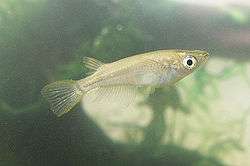Japanese rice fish
| Japanese rice fish | |
|---|---|
 | |
| Oryzias latipes | |
| Scientific classification | |
| Kingdom: | Animalia |
| Phylum: | Chordata |
| Class: | Actinopterygii |
| Order: | Beloniformes |
| Family: | Adrianichthyidae |
| Subfamily: | Oryziinae |
| Genus: | Oryzias |
| Species: | O. latipes |
| Binomial name | |
| Oryzias latipes Temminck & Schlegel 1846 | |
The Japanese rice fish (Oryzias latipes), also known as the medaka and Japanese killifish,[1] is a member of genus Oryzias (ricefish), the only genus in the subfamily Oryziinae. This small (up to 3.2 cm or 1.3 in) native of east and mainland southeast Asia is a common denizen of rice paddies, marshes, ponds, slow-moving streams and tide pools.[2] It is euryhaline, occurring in both brackish and freshwater.[2] It became popular as an aquarium fish because of its hardiness and pleasant coloration: its coloration varies from brown or yellow-gold in the wild to white, creamy yellow, or orange in aquarium-bred individuals. The medaka has been a popular pet since the 17th century in Japan. The female carries her eggs attached between her anal fins.
Description
Oryzias latipes is a model organism and is extensively used in many areas of biological research, most notably in toxicology. Medaka have a short gestation period, and are reproductively prolific — characteristics that make them easy to rear in the laboratory. They can withstand cold and can be shipped easily. Nearly all aspects of the life cycle of medaka have been analyzed by researchers including sexual behavior, genetic inheritance of coloration, spawning habits, feeding, pathology, embryological development, ecology, etc.[3] [4] It has relatively small genome (~800 mega base pairs, half the size of the genome of another popular model fish, the zebrafish) as well as a generation time of 7 weeks (rather than 9 weeks for zebrafish) and hardier growth in a broad temperature range (6–40 degrees °C).[5][6]
-2.jpg)
Transgenic medaka are relatively easy to produce. They have been genetically modified to secrete various human hormones, express promoter sequences from other fish, and to make antimicrobial proteins and a protein that makes the medaka glow fluorescent green.[7] There are also many mutations that show up in medaka at random, for example, a mutant strain that lacks scales, and one with extra-long fins. Haploid embryonic stem cell lines have been established.[8]
In space
O. latipes carries the distinction of having been the first vertebrate to mate in orbit.[9] The result of the mating was a brood of healthy fry, hatched on the Space Shuttle Columbia in 1994. O. latipes returned to space in 2012, launched aboard a Soyuz spacecraft Soyuz TMA-06M and housed in an aquarium aboard the International Space Station.
References
- ↑ หน้า 26-27, สกุล Oryzias ปลาข้าวสาร โดย สุริศา ซอมาดี. "Mini Atlas". นิตยสาร Aquarium Biz ปีที่ 5 ฉบับที่ 49: กรกฎาคม 2014 (Thai)
- 1 2 Froese, Rainer and Pauly, Daniel, eds. (2014). "Oryzias latipes" in FishBase. April 2014 version.
- ↑ Leroi, Armand Marie. (2003). Mutants: On Genetic Variety and the Human Body. New York: Viking. ISBN 0-670-03110-0.
- ↑ "Major topic "Oryzias": free full-text articles in National Library of Medicine".
- ↑ "Oryzias latipes, medaka as a model organism: taxonomy, facts, development stages, bibliography at GeoChemBio".
- ↑ "Medaka (Oryzias latipes) Genome Browser Gateway".
- ↑ Tanaka M, Kinoshita M, Kobayashi D, Nagahama Y (2001). "Establishment of medaka (Oryzias latipes) transgenic lines with the expression of green fluorescent protein fluorescence exclusively in germ cells: a useful model to monitor germ cells in a live vertebrate.". Proc Natl Acad Sci USA. 98 (5): 2544–9. doi:10.1073/pnas.041315498. PMC 30174
 . PMID 11226275.
. PMID 11226275. - ↑ Yi, M., et al. Generation of medaka fish haploid embryonic stem cells. Science 326(5951), 430-33, 16 October 2009.
- ↑ "Medaka aboard Columbia".
External links
- View the oryLat2 genome assembly in the UCSC Genome Browser.
- Medaka genome in Ensembl.
| Look up Medaka in Wiktionary, the free dictionary. |
| Wikimedia Commons has media related to: |
| Wikispecies has information related to: Oryzias latipes |